Women’s Guide to Cyber Safety 2025

Women and girls are both the targets and scapegoats of online harassment; we’re singled out and then victim-blamed as though we asked to be persecuted. The cycle has been vicious and endless, but not anymore. It’s time for us to take control and put an end to the attacks on women online.
Online, women are subjected to harassment, violence, oppression, and just generally uncomfortable situations that few (if any) men have to deal with. The Economist Intelligence Unit conducted a study reporting that 85% of women worldwide had witnessed online violence against other women. In the EU alone, 10% of women report having experienced cyber-harassment since age 15.
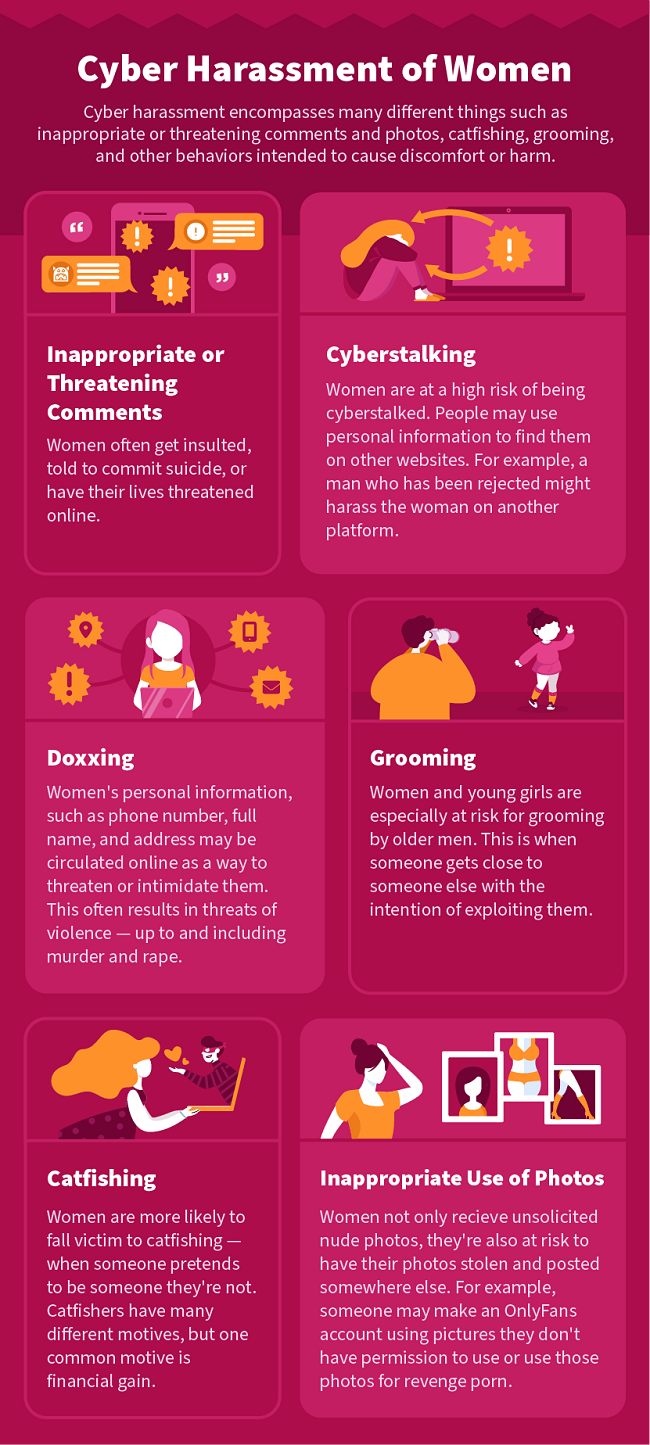
The effects of cyber harassment can be debilitating and have real-life consequences such as low self-esteem, insomnia, depression, and suicidal thoughts. Fortunately, the ever-growing awareness of cyber violence against women has brought with it some useful tools and strategies for preventing and addressing online harassment.
You have a right to feel safe in your own skin and participate in the world in all of its forms. With this cyber safety guide, you’ll have the tools you need to minimize, prevent, and handle the many different forms of online harassment. Editor’s Note: We value our relationship with our readers, and we strive to earn your trust through transparency and integrity. We are in the same ownership group as some of the industry-leading products reviewed on this site: ExpressVPN, Cyberghost, Private Internet Access, and Intego. However, this does not affect our review process, as we adhere to a strict testing methodology.
How to Protect Yourself from Social Media Harassment
The most frequent social media users worldwide are 15-year-old girls, and unfortunately, this is also the age at which most girls report their first encounter with online harassment. While young girls typically learn better strategies for managing online harassment as they age and continue using social media, 42% of women’s behavioral response toward harassment is still simply to ignore it.
Harassment on social media isn’t limited to women alone, but there’s no denying that social media harassment is far worse for women than it is for men. Women have to deal with disgusting comments about their bodies, unsolicited dick pics, death threats, rape threats, and worse. And studies show that trans women are even more at risk for incurring violence on and offline. Online transphobia and harassment towards trans women often involves intentional misgendering, deadnaming, and transphobic slurs, all of which take a significant toll on trans women’s mental health and self-esteem.
It’s not all bad news, though. Women everywhere are empowering themselves with social media to call attention to these issues and more, mainly through the #metoo movement. Beyond drawing attention to the violence and maltreatment individual women experience, the movement is awakening the world to the larger systemic issues women face.
We have the right to feel safe in person, and we deserve to feel secure online. Protecting yourself from social media harassment doesn’t mean you have to delete your accounts and lose touch with your network, though.
There are actually a lot of things you can do to protect yourself and still participate. Some sites and apps have platform-specific options, but there are some general guidelines and tips that apply everywhere.
To make things easy. I’ve outlined both things women can do in general and platform-specific features that can keep you safe.
Social Media Best Practices

The first thing you should do when someone starts harassing you or you see someone being harassed is to block and report them. This isn’t an ideal system, because we know from past controversies that clear harassment sometimes gets ignored and people can make new accounts after you block them. But at least this way, the person can’t contact you anymore.

Pretty much all apps and websites give you the ability to prevent others from tagging, manage who can send you direct messages, and control your discoverability. You may want to leave your profile open on some sites and make it very private on others, but I highly recommend at the very least choosing the options that don’t allow strangers to DM you. Once I did that, it made my inbox a much friendlier place to be.

It’s nearly never a good idea to tag your exact location on social media in the moment. This leaves you open to stalking and makes your profiles much easier for random weirdos to find. If you do want to share your location, do it after you’ve left or choose something more general. For example, choose the city you’re in — not the neighborhood.

Be mindful of whose friend requests you accept. If their name and profile picture don’t ring a bell and you have no mutual friends, it’s probably not a good idea to accept. These followers could be scammers, bots, or, worst of all, a “finsta” (fake Instagram) account. Finstas are becoming a popular way to hide what you’re doing from other people as well as stalk people who have blocked them. If you do accept requests from people you don’t know or from business accounts, be careful not to share too much personal information.
Amnesty International has long criticized Twitter for its lax response to violence and abuse toward women. Despite some minor progress over the last few years, the fact is the company isn’t doing enough to protect women, especially women of racial, ethnic, or other minority groups.
For example, actress Leslie Jones felt forced to leave Twitter after the 2016 reboot of Ghostbusters was released. As the only woman of color on the cast, she was singled out from the rest of the women. She received so many racist comments and threats that she felt she had no choice but to step away from the platform — as Twitter wasn’t doing enough to stop the harassment.
Jones’ treatment may seem extreme, but it’s just another day in the life of a woman expressing herself (or even just existing) on Twitter. Even less famous, or not famous at all, women have to put up with constant streams of insults and threats.
However, while Twitter’s history is bleak, there are several ways you can protect yourself on the site.
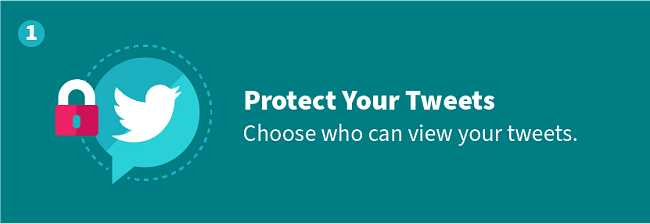
More often than not, women are harassed online by strangers or anonymous accounts on the internet. The best way to avoid unwanted attention from strangers is to “protect” your Tweets. This means that only your followers can see what you tweet and your full profile information. It also means that you have to approve each new follower.
If you prefer not to protect your Tweets, another thing you can do is to limit who can reply. You can choose to allow anyone to reply, only people you follow, or only people you mention. This may be particularly helpful if you’re tweeting about something controversial.
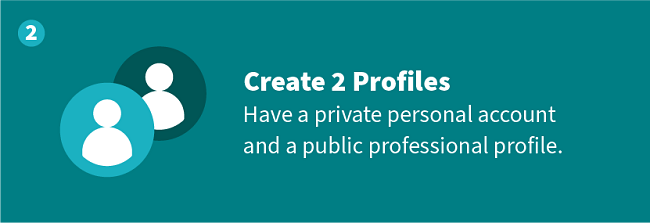
As women, we understand that workplace harassment is no joke. Unfortunately, this can also extend to work-related Twitter accounts. If you have to maintain a Twitter account for your professional life, I highly suggest creating separate accounts. This way you can limit who has access to your personal information while still attracting followers and growing your network.
Facebook and Instagram
It’s easy to feel comfortable sharing personal information on Facebook because that’s what it was designed to do. Unfortunately, there’s no way to really verify that someone you’re friends with on Facebook is who they say they are, so you never really know who has access to what you’re putting on the platform.
Women are at high risk for harassment because of the nature of Instagram. The rush of people liking your pictures and the ability to monetize your account make it appealing to have a public account and add as many followers as possible. But this also leaves you open to harassment from strangers.
Worse yet, as 2021 leaks from the Facebook corporation (now called Meta) showed, Meta is apathetic towards the removal of harmful content and is fully aware of the damage that its platforms can do.
This is why it’s vital for women to be mindful of what they share and who can see it. Here are some of the ways you can take back control of your Facebook and Instagram accounts.
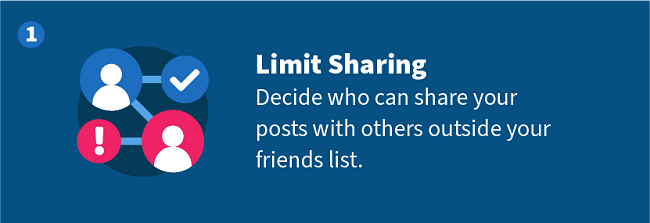
The best way to avoid unwanted comments from strangers on Facebook and Instagram is to make it so they can’t see your posts in the first place. You can set your profile to private and turn off sharing so your friends can’t share your posts with their friends. This isn’t a foolproof way to ensure unwanted viewers don’t see your posts, but it does make it less likely.
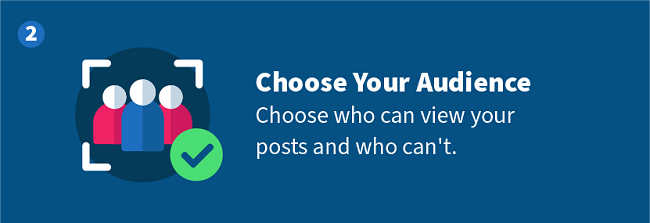
Facebook and Instagram allow you to control who can see your posts: friends, friends of friends (only on Facebook), only you, or everyone. You can create a default audience for each part of your profile, and change audiences for individual posts if you prefer.
Both apps feature disappearing videos and photos that you can share to your story and these have the same privacy controls as your main feed. You can create lists of close friends to share with or share them with all of your friends and followers. Remember though, even though these disappear after 24 hours, people can still screenshot them or take a picture with another device so you won’t get a screenshot notification.
There’s nothing wrong with wanting public profiles on Facebook and Instagram. It’s fun to share your opinions with the world! If you do, I highly recommend creating one profile that’s open to the public and one that is private and only for people you know.
TikTok
TikTok has taken off as a fun social media platform for creative videos. Unfortunately, just like more established social media sites, TikTok is also a frequent site for the harassment of women, cyberbullying, and inappropriate content. The good news is that TikTok offers very granular control of who can see what you post, who can comment, who can tag you, and much more.
One of TikTok’s biggest assets and one of the things that makes it so dangerous is its state-of-the-art algorithm. When you have an open profile, your videos are shown to random people based on your location, the content of the video, and your followers.
Unlike other sites and apps, there is no way to completely disable TikTok’s access to your location. You can disable location services, but the app says “If you turn off location services, TikTok will continue to estimate your location based on your system/carrier information and your IP address.” Even when using a VPN, TikTok still shows me content that is clearly based on the country I’m in.
One of the coolest things about TikTok is its video collaboration tools. So, when thinking about privacy on TikTok, the first thing you have to decide is how you want to engage with other users. If a harasser makes a duet or stitches your video, that video becomes their content. After that, because of TikTok’s algorithm, it’s likely to end up in the feeds of other people who will pile on the abuse.
Fortunately, TikTok’s settings allow you to choose exactly who can see your videos and who can do what with them. You can choose to allow “followers”, “followers that you follow back”, or “only me” separately for pretty much every feature the app offers.
If you want to allow duets and stitches, you should keep these set to “followers that you follow back”. That way you can enjoy collaborating with others and know where your content is being posted.
Snapchat
Snapchat was one of the first apps to introduce disappearing messages and photos. Even though it’s less popular than it used to be, people still use it for those features because it’s so ubiquitous. There aren’t as many ways to secure your profile as other apps but it’s got the same core privacy settings as most. You can set your account to private, hide your location, and choose who can and can’t contact you. Check out Snapchat’s privacy settings tutorial to see how to secure your profile.
LinkedIn is a hybrid of social media and workplace. As a professional networking and job hunting service, it’s intended for professional use, but it operates like other major social media platforms. Unfortunately, women experience harassment here as well.
Women have reported being asked out through LinkedIn messages, receiving misogynistic comments on posts, and have even had personal information obtained through their resumes and exploited. While users don’t have the anonymity on LinkedIn as they may on other sites, the harassment on LinkedIn is no less severe and no less dangerous.
Here are some ways you can protect yourself on LinkedIn:
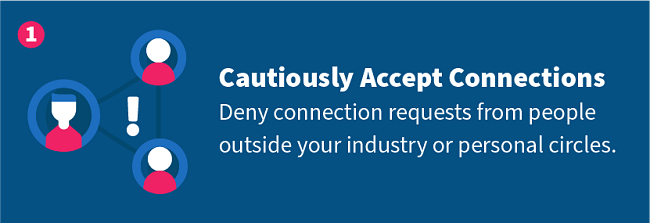
You can assess requested connections by looking at LinkedIn’s degrees of separation, checking to see if you are in the same industry, and reviewing their profile. If you don’t know them and they’re not in your line of work, it’s safer to deny the connection request.
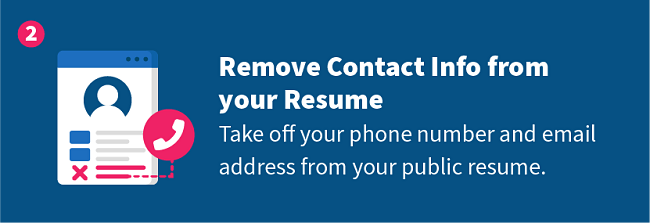
You should keep your phone number and home address off your LinkedIn resume to prevent further unwanted and anonymous contact. At least if you’re messaged on LinkedIn, you can view the messenger’s name and profile.
How You Can Safely Share Photos
Nasty comments on pictures have become one of the biggest ways that women are abused and harassed on the internet. Unfortunately, many people feel like a shared picture is an invitation to share an (unasked for) opinion on a woman’s body, sexuality, clothing, and more.
Instagram is one of the worst places for this, but the sad fact is that Meta has acknowledged that its apps are problematic and still does nothing about it. That means that, for now, the burden is on us to do the best we can to protect ourselves.
And women don’t just have to worry about what they post on social media. We also have to worry about what we send to people privately. Revenge porn, deep fakes, and just pictures being shared with other people or websites without consent have become a huge problem.
There are no hard and fast rules about how to avoid issues with sharing pictures. There are valid reasons for sharing personal moments in our lives and we shouldn’t have to lock ourselves away in order to avoid being a victim. The good news is that there are things we can do to mitigate harassment, while still being able to share our gorgeous photos.
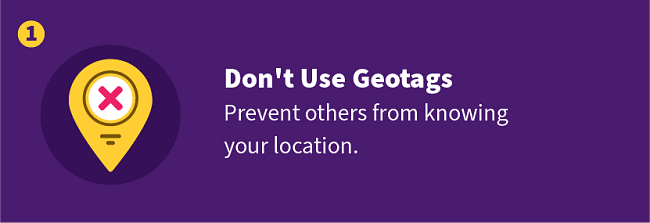
Geotags indicate your location or the location in which a photo or video was taken. Sites like Instagram and Facebook allow you to tag your photos with a location. When you add that tag, anyone can see your picture when they search for that tag (unless your profile is locked or private). Avoiding the use of geotags helps prevent online harassment from turning into in-person conflict.
If you do want to let people know where you are, you can add a geotag after you have left, choose a more general location (for example choose the city you’re in and not the exact location), or restrict who can view any picture you’ve geotagged.
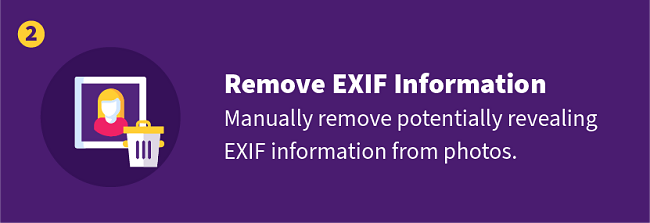
EXIF information is the information your camera stores about your photos. These details include the name of your device, the settings you used to take the picture, where and when the picture was taken, and sometimes the serial number of your camera.
Although in most cases it’s not possible to have instant access to this information about someone else’s pictures, there are programs designed to reveal EXIF data on pictures that aren’t yours. So, if someone wanted to get that info — they could.
There are ways to disable and edit EXIF data from your device directly, although these differ greatly depending on what you’ve used to take the pictures. There are also apps you can get for any device that are designed to strip EXIF data from your pictures. Read more about what EXIF data can be used for and how to remove it from Consumer Reports.
Although it’s scrubbed by most social media sites and encrypted messaging apps, EXIF data is preserved when you share a picture through email or an SMS. If you want to keep some EXIF data, but don’t fully trust the person you’re sharing pictures with, you should at least remove the location data before sharing — no matter how or what you’re sharing.
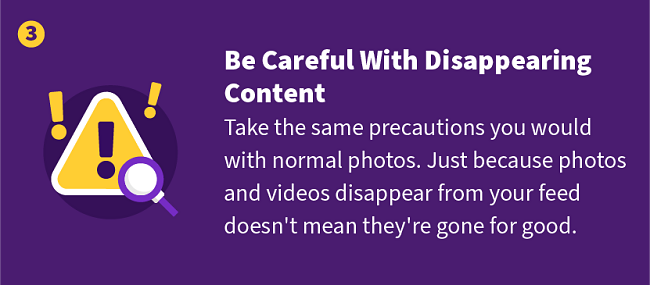
Needless to say, disappearing content is one of many methods aggressors use to harass women online. Both Snapchat and Instagram have features where photos and videos disappear after a certain amount of time. Because these messages and posts disappear, people often send things through Snapchat or post stuff on their stories that they wouldn’t if it were more permanent. However, abusers and harassers can still save them — either by taking screenshots and screen recordings or taking a photo with another device.
While Snapchat was once the go-to app for steamy activities, other safer options have been developed in recent years. Dust is a highly encrypted app that doesn’t show your name on-screen with your messages and photos, making it difficult for anyone to tie the messages back to you. Confide is another popular choice, especially for sending nudes, because of its screenshot blurring feature that helps prevent the possibility of revenge porn.
How to Use Messaging Apps Safely
Inappropriate and graphic comments and photos, catfishing, cyberstalking, and scams are all common problems women encounter on messaging apps. The structure, features, and privacy settings of each app somewhat indicate how difficult it is to confront harassment when it occurs on the platform.
Messaging apps like WhatsApp, Kik, and Discord are popular places for both old and new friends, as they provide encrypted platforms that make communication instantaneous and secure. Most messaging apps are more secure than SMS messaging, and this is attracting billions of users to their platforms per year. Just like other online spaces, however, messaging apps have a dark side and pose risks for users, especially young women.
Despite the risks involved in using any of these apps, messaging apps aren’t inherently bad. So, don’t trash your messaging apps and go back to SMS messaging just yet. With the right app and safety strategies, you can communicate confidently and put a stop to harassment before it escalates.
You’ll notice by now, though, that many of the best practices for one segment of online life hold true for other virtual spaces as well. Practicing these strategies consistently across all platforms is the strongest way to defend against cyber-harassment and take control of your online presence.
Kik
Kik is an entirely anonymous messaging app featuring a high degree of encryption. While these features could be perceived as a win for privacy, they can simultaneously be seen as an antagonist of justice. Because it’s completely anonymous and doesn’t require anything except an email address to join — it’s full of scammers, bots, catfishers, and creeps. Horror stories like that of 13-year-old Nicole Lovell’s murder illustrate just how severely harassment can escalate from the app to real life and how difficult it can be for law enforcement to get the information they need to identify suspects or get a conviction.
Follow these steps to say safe on Kik:
- Don’t use your real name.
- Ask for “live” photos or videos to verify identities.
- Turn off PMs from group settings.
Discord
Discord, originally designed as a communication platform for gamers, also hosts chat rooms for topics outside of gaming such as book clubs, music group fandoms, explicit content, and more. Like with Kik, there is a degree of anonymity within Discord servers, as users are identified by a chosen username instead of their real name, and minimal personal details are required to make an account.
However, the relative anonymity and the growing popularity of Discord amongst younger age groups have attracted sexual predators to the servers. Forty-year-old Nathan Larson, for example, groomed a 12-year-old girl on Discord and eventually manipulated her into running away with him in the middle of the night.
Follow these steps to protect yourself on Discord:
- Select the degree to which Discord scans and blocks direct messages you receive based on explicit content.
- Choose who can send you friend requests (everyone, friends of friends, or server members), and don’t add people you don’t know.
As a completely free texting and VoIP (voice-over-IP) service, WhatsApp has gained a huge amount of popularity all over the world. Businesses have even begun using it for official communications and processing payments. Although it claims to be end-to-end encrypted, it’s owned by Meta and there have been a number of privacy scandals over the years (some related to sharing data with Facebook and some related to hacking vulnerabilities). Although I use WhatsApp for almost all of my texting, I still don’t trust it with my personal information any more than I trust Facebook (not much).
There aren’t many ways to “stay safe” on WhatsApp that are specific to the platform. The only thing that is different in the app is that you can disable being automatically added to a group chat, and you can hide whether you are online and when you were last online. So my best advice is to treat this app the way you do your SMS service.
Just like with SMS, you can turn off read receipts, and you can block someone if they’re bothering you. You can also report people who have sent you inappropriate messages, but be aware that this will send the previous 5 messages from your chat to WhatsApp. Just like every other platform, the platform says that offenders could get banned but there’s no guarantee any action will be taken.
Signal: The Safest Messaging App
Signal is by far the best option for a third-party messaging app as it’s renowned for its privacy and security. Because Signal was designed with security in mind, you don’t have to worry about updating privacy settings — safety is the default. Signal is completely free, available on Apple and Android devices, and only requires a phone number.
How to Safely Use Online Forums
As with all other internet spaces, online forums are hazardous for women. Reddit, one of the most popular discussion platforms, is widely known for its crude content, harassment, trolling, and other problems. This isn’t surprising since Reddit is the seventh most popular site in the US and nineteenth worldwide.
Historically, the millions of people who flock to the platform find “subreddits” based on their interests, which could include anything from innocent pages full of animal pictures to people who identify as incels and use the forum to spread their hatred for women.
Trolls have a long history of invading online spaces not meant for them for the sole purpose of harassing others, most often women and racial minorities. Participants in the r/BlackGirls subreddit experienced racist and misogynistic comments from trolls in what was intended as a safe space for black women to connect. When they started a new subreddit called r/BlackLadies to escape the harassment, the trolls migrated with them.
Similarly, the r/rape subreddit was intended to be a safe place for victims of sexual assault. Unfortunately, it saw its fair share of victim-blaming, violent, and otherwise inappropriate comments from trolls as well before Reddit decided to shut it down. Although it has finally taken steps to tackle the issues prevalent across the site, its staff has long been criticized for its emphasis on free speech over the safety of its users.
Whether you use Reddit, Quora, or another popular online forum platform, the best practices for safety are the same.
Follow these steps to say safe on forums:
- Provide as little personal or identifying information as possible.
- Use a burner email service to sign up.
- Create throwaway accounts if you’re going to ask for advice or give potentially identifying information.
- Turn off notifications for responses to your posts and comments if things heat up.
How to Handle Virtual Workplace Harassment
While the most common forms of cyber harassment happen on social media, online workplace harassment against women is also an issue. Since so much of our work nowadays is done online, this problem has only gotten worse. You have a right to feel safe and confident at work, even if your “work” is technically at your home office via Zoom, Slack, or Microsoft Teams.
People interact differently online, even coworkers you may actually know in person. The anonymity people feel from behind the screen often empowers them to do things they wouldn’t normally do in person. According to one study, 52% of women have experienced harassment at work in the past year.
The harassment women face in the virtual workplace has ranged from inappropriate comments (verbal or text), unprofessional images or videos, threatening behavior, and beyond. It can be difficult sometimes to know what counts as harassment. Some instances of harassment are obvious, like Jeffrey Toobin’s masturbating on Zoom. Other examples may not be so clear, like when Joe from marketing makes those slightly inappropriate jokes to you in the meeting chat. A good rule of thumb is if you’re ever in professional situations where you feel uncomfortable, start keeping a record.
Here are some important steps you can take to handle workplace harassment:
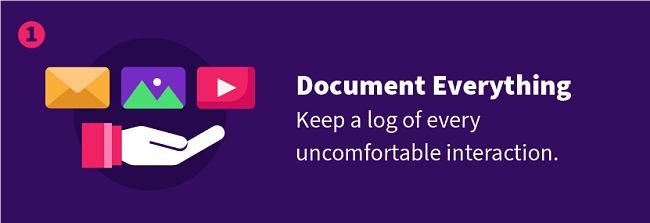
Keeping a record of everything someone does to make you uncomfortable will only strengthen your case. Every comment, email, or other inappropriate correspondence is essential evidence, should the interactions have been intentional or persist. Keep screenshots, log the dates and times of any incidents, and maintain a file of anything related to your interactions with that person.
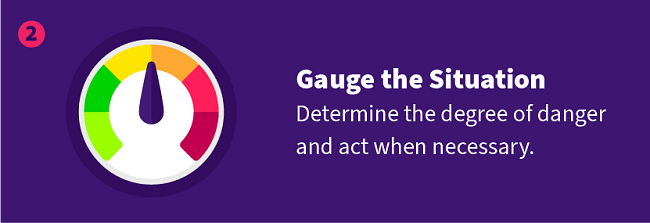
You should report any and all harassment you encounter. But if you notice an escalation of the harassment in degree or frequency, it might be time to act sooner rather than later. If you feel the inappropriate communication is less blatant or infrequent, it may be best to continue documenting the situation and wait until a significant body of evidence has accumulated before moving forward.
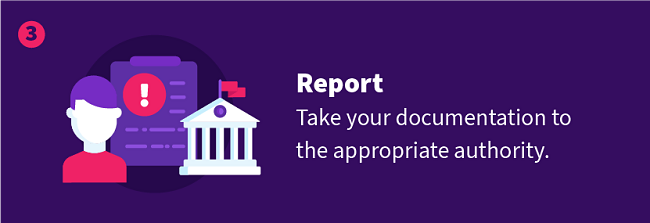
Once you have proof of the harassment, it’s time to take the problem to management. Go to your HR department or management and request the next steps for how you should proceed. Each workplace usually has its own policy outlining how harassment should be handled. If you are unhappy with the way they handle the situation, or perhaps your aggressor is your HR representative or manager, seek legal counsel.
Online Dating & Sexual Harassment
Online dating is now so integrated into our society and culture, that over 44 million people use online dating services today. Among those users, 60% of women 18-34 years old reported being contacted by someone even after saying they were no longer interested, and 57% said they’d received unrequested inappropriate messages.
While apps and dating sites make it easy to meet new people, this convenience comes with a high risk, especially for women. Like on social media and virtual workplaces, harassment on dating sites is rampant, and it takes many forms. Dating apps are a hotspot for catfishing and romance scams, and it’s all too easy to fall victim to these ruses.
Here are some ways you can make sure you stay safe:
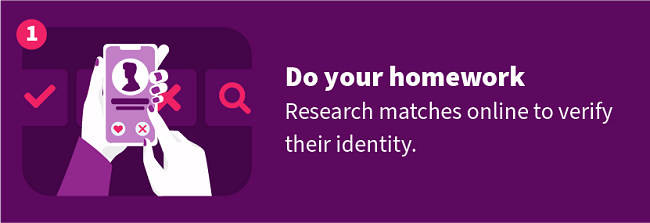
A quick Google search goes a long way. Look up the people you’re talking to on social media. No trace of them anywhere? Be suspicious of a minimal online presence.
It’s not necessarily a red flag for someone to have a small digital footprint. If something feels off, do a reverse image search to check whether the person’s pictures are being used elsewhere.
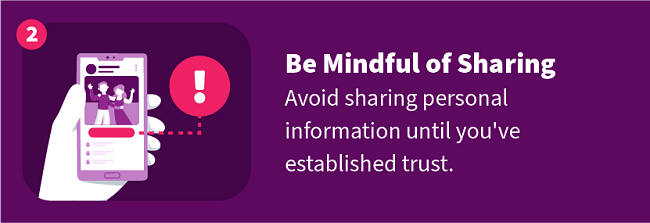
Keep your contact information private until you’re confident in sharing it. Sexting and sending nudes is normal and can add excitement to relationships, new or old. However, it’s important to know that you can’t guarantee where they’ll end up or how they’ll be used once they’re out in cyberspace.
There is risk involved, no matter who you’re sharing nudes with. The best thing you can do is avoid showing distinguishing features (such as tattoos, beauty marks, your face, etc) in the photos you share, and follow these tips for safely sharing pictures.
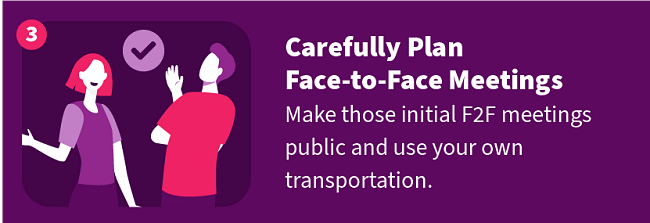
When you decide to meet someone face-to-face, meet in a public place during the day, let close friends and family know where you’ll be, and drive yourself or take public transportation. If your date insists on picking you up or meeting at your place, that’s a red flag!
Sharing your location with trusted friends is a great way to stay safe while going on an in-person date. I always used to schedule a call or text with a friend to check in and make sure everything is going okay.
It’s also not a bad idea to familiarize yourself with your phone’s emergency response shortcuts. Both iPhones and Android phones have built-in SOS call options. There are specific SOS apps out there, but the availability and features vary greatly based on your location and your budget.
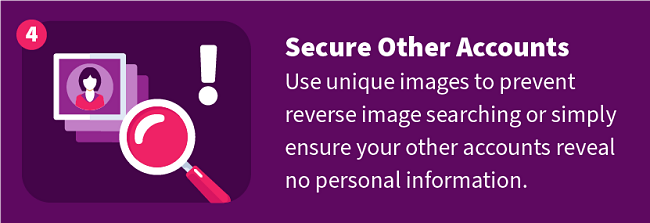
If you’re looking up your match online, chances are good that they are looking you up too. If you want to minimize their ability to investigate you, consider using images on your dating profiles that don’t show up on your other social media accounts.
If you choose to use some of the same photos, ensure your other accounts are not revealing personal information to strangers. Your match knowing you have other profiles will give them confidence that you are who you say you are, but concealing your personal details beyond that will help keep you safe.
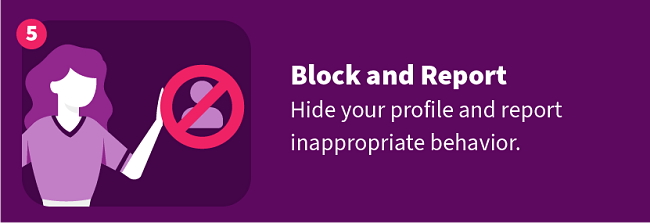
If you experience inappropriate comments, uncomfortable interactions, or aggression on a dating site, block and report the offender. Reporting harassment lowers the chance that a person will continue their behavior towards you and others.
Fortunately, most dating apps have reporting features on all profile pages and messaging windows and actively encourage users to report all policy violations. Terms and conditions are usually pretty common sense: no asking for money, no pretending to be someone you’re not, no sending harassing messages or explicit photos, etc. But if you’re unsure what you can report on dating apps, check out the safety tips and policies for the app you’re using.
Ghosting someone on a dating app (or in real life) gets a bad reputation, but I don’t think you should feel bad about it at all. Women are in danger from men being abusive or violent after being rejected and we need to prioritize our safety over anything else.
Online Gaming Harassment Towards Women
Online gaming is a lot like physical sports in the sense that there is a competitive culture, so much so that trash talking and insults are essentially part of the gaming experience itself. Beyond the friendly competition, however, there is significant sexism within gaming culture that has put women, particularly women of color, in the line of fire. Women comprise roughly 41% of all gamers but are still subjected to overwhelming harassment on and offline due to their participation in online gaming.
Sexual comments, insults, and threats of violence are all forms of harassment that women experience online. And unfortunately, harassment isn’t taken seriously by male gamers simply because it’s a woman doing the reporting. The response from the community is often some form of “this is why women don’t belong here” or “if you can’t handle it, log off” and “this is just the way men are.”
In 2020, 70 prominent gamers, most of whom identify as women, came forward with their personal experiences of sexual harassment and other gender-based discrimination in the industry. They took a similar approach to women of the #metoo movement, empowering themselves and drawing attention to the injustices they incurred by sharing their stories and outing the culprits on social media.
Online games, like sports, are meant to be fun, competitive, challenging, and communal, and yet nearly half of the gaming community doesn’t consistently reap these benefits. For example, at a tournament, competitive gamer Miranda Pakozdi intentionally sabotaged her game to escape the sexual harassment by her team’s coach throughout the competition.
While some women may decide to walk away from gaming or play alone, there are other available options for managing and preventing gender-based harassment in the gaming community.
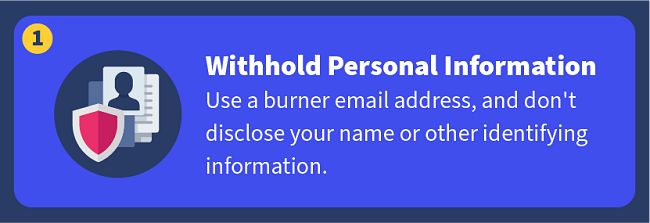
Some basic video game safety includes never revealing your name, location, or other personal identifiers like your email and home address, phone number, or birthday. Consider keeping your gaming life entirely separate from everything else, and sign up with a burner email and false information. Doing so helps prevent doxxing.
Rather than using a photo of yourself in your gaming profile, build an avatar. For safety purposes, your avatar shouldn’t resemble you, and you can even make your avatar gender-ambiguous if you wish to conceal your gender to other gamers. Craft your Gamertag with care; avoid including any iteration of your name or your other online handles. Following these rules of thumb will help prevent any harassment from extending beyond the gaming realm to real life.
If you decide to create a male persona, be careful not to reveal your true gender identity. Ironically, if you choose to create a male online persona, you may open yourself to more and worse harassment if your gamer-bros find out and feel “deceived”.
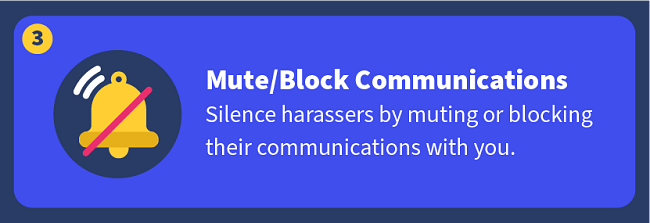
When it comes to confronting harassment, there are several useful strategies, many of which mirror the courses of action in other online spaces. For example, muting or blocking communications from gamers who refuse to respect you.
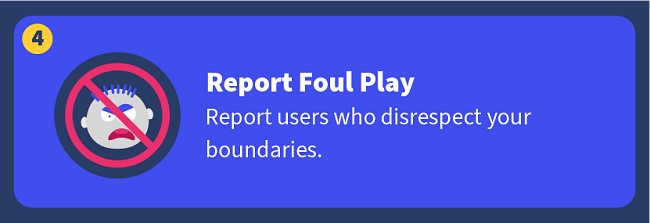
The good news is that many gaming platforms and developers are realizing how big of a problem the harassment of women gamers is and are being more responsive with bans and policy changes than social media platforms.
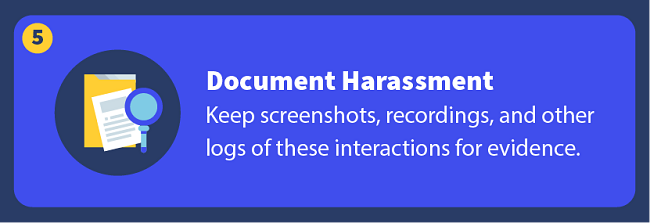
Document any harassment you experience, especially if your instinct tells you it may escalate. Keeping a record of your experience will help in the event that you need to turn to law enforcement to intervene. Screenshots, logs, and recordings are all useful ways of documenting evidence of harassment.
How You Can Prevent and Stop Hacking and Doxxing
Hacking and doxxing are two major attacks that can happen to women. Both are invasions of privacy, but even worse they can endanger a woman’s job, family, reputation, and her own life.
Hacking is how internet users get your personal information and doxxing is when that information is shared publicly for malicious purposes.
There are dozens (at least) of examples of women’s lives being put in danger after their phone number, address, or other personal information got posted online. One of the most famous is game developer Brianna Wu who was in the middle of the GamerGate saga in 2014. She was stalked, harassed (sexually and otherwise), and her life was threatened. On top of name-calling and other forms of harassment, she has seen first-hand how everyday women can get doxxed by cybercriminals. A SWAT team visited one friend of Brianna’s after someone falsely reported her for committing criminal activity. Photos of another friend’s children were posted to pedophile chat rooms.
Although there are many high-profile victims of doxxing (Beyonce, Kim Kardashian, and Hilary Clinton, to name a few), it’s just as common for it to happen to everyday people. In another example, a woman who didn’t want to be named recounted her experiences when someone out for revenge posted an ad on Craigslist with her phone number. She received hundreds of explicit texts, which often included equally explicit photos. And she never found out who had doxxed her.
Hacking and doxxing often go hand-in-hand, but sometimes the people who dox women find their personal details from publicly available information. The first step to ending this type of harassment is to make sure you haven’t been hacked. The second step is to take action to end the harassment.
There are many different ways for hackers to access your information, so it’s essential to know the signs that you’ve been hacked and what you can do to stop it or prevent it altogether.
Here are a few things to look for if you think you may have been hacked:
- Check your accounts—Make sure you can access all of your accounts: social media, banks, and other profiles online. If your password doesn’t work or you find suspicious activity on your accounts (like friends receiving unusual messages from you), it may be a sign that you have been hacked.
Being unable to access key system settings also indicates a breach in your cyber security. The best ways to avoid these types of attacks are to use strong passwords, set up a firewall, and avoid email phishing scams. You can also enable two-factor authentication to strengthen your security, so it takes more than just your password to log into your accounts. Microsoft concluded that utilizing two-factor authentication blocks 99.9% of automated attacks. - Suspicious apps on your device—If you come across apps you don’t recall ever installing or seeing on your device, they could be malware. Malware is any kind of malicious software designed to compromise system security, and it’s a common way for hackers to get your information.
If you have malware on your device, you will likely see strange pop-ups and fake antivirus software messages. A good rule of thumb is to vet all software thoroughly before downloading it to your device, and never add anything that seems suspicious or disreputable. - Redirected homepage—When you open your internet browser, you may find that your normal homepage is redirected to an unfamiliar site. While sometimes, this is simply a user mistake that can be easily corrected, other times it is a sign that someone has hacked you. To stop this, remove any unknown third-party browser add-ons, extensions, or toolbars. You should also change your browser’s homepage back to the default and restart your device. If the problem persists, it may be a sign of a more severe malware problem.
While it’s nearly impossible to completely eliminate the threat of doxxing online, there are several safety tips to help prevent yourself from falling victim to doxxing:
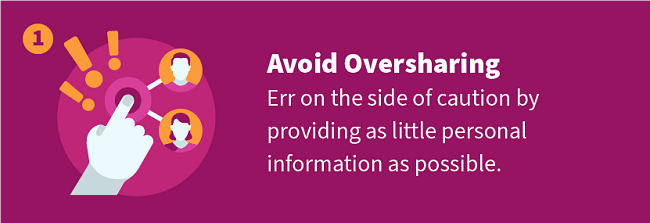
This may seem obvious, but it’s so easy to overshare online. Be extremely careful what, how, and with whom you’re sharing sensitive information. Anything tied to your identity or finances should be kept in the strictest confidence and only shared when absolutely necessary. Be mindful of the personal details you reveal in forums like Reddit and Quora as well if you use them. So-called internet detectives can dig up information on you from the barest of details.
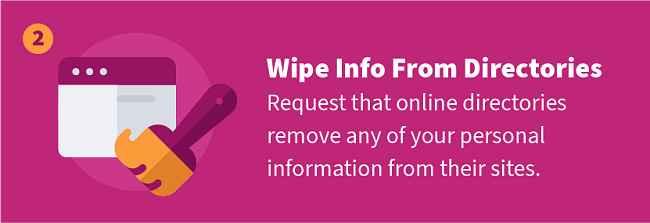
Online directories such as whitepages.com and peoplefinder.com have information about you that they sell to others for a small fee. Worse yet, there are other sites (which I will not name) that include much more detailed information like income, relatives, past and present addresses, email addresses, social media accounts, criminal reports, and more.
If you reach out to these sites and request your information to be removed, those sites legally have to comply for privacy purposes. Unfortunately, for some of the worse sites, you may have to request to have your information removed annually as most of it is considered public information and thus not illegal to distribute.
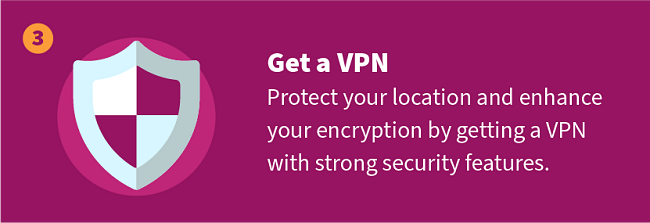
VPNs hide your IP address, which can reveal your location. Look for VPNs that have advanced encryption and kill switches to protect your data while you’re online.
If you’ve already been doxxed, I’ve rounded up some advice for how to stop the harassment, or at least lessen the impact.
- Block and report — As previously discussed, blocking and reporting is an imperfect solution, even though it should be your go-to. The good news about reporting that you’ve been doxxed is that it’s usually taken much more seriously than harassment.
- Lock down your social media — There are lots of steps you can take to make it so you’re difficult to communicate with online. You may not be able to stop people from posting about you, but you can certainly make it so that it’s harder for you to see.
- Call the police — Doxxing is considered a cybercrime in a lot of jurisdictions, so don’t be scared to call local law enforcement. Be ready though, the police may be unwilling or unable to provide much help — especially if you’re unsure who has doxxed you. Nevertheless, make sure the police at least file a report as this documentation can help speed up the process of getting a restraining order or preventing getting swatted. And remember, when your safety is threatened, you have the right to be taken seriously by the police. If the responding officer is rude or unhelpful, don’t hesitate to ask to speak to someone higher up in the chain of command. Not all police have a thorough knowledge of what is and isn’t a crime or what to do when one is being committed.
- Don’t delete your accounts — Although it may seem counterintuitive, and it will certainly go against your desires, don’t delete your accounts just yet. Anti-revenge porn activist Charlotte Laws recommends actually increasing your online presence to drown out the trolls. You’ll probably need to lock down your profiles so that the harassers can’t comment on your posts or DM you, as well as delete some posts, but this may still be a strategy that works for you. In dire situations, you could also consider hiring a company that will work to improve your SEO.
- Get help — You’re not the first, last, or only person to ever get doxxed and you probably didn’t do anything to deserve it. When the harassment becomes too much to handle, consider letting a trusted friend take over your social media accounts and ask them to filter your messages for you.
What You Can Do as a Parent
Young girls are at serious risk for online harassment. Although it’s impossible to forbid your daughters from accessing the internet or take away their smartphones completely, there are a few things you can do to try to help.
- Keep the lines of communication open — Having an open and trusting relationship with your daughter will help her feel more comfortable talking to you when something isn’t right. Make sure you’re talking about how to share things safely and what to do when something feels off.
- Take it seriously — There are countless examples of women and girls not being taken seriously when reporting abuse. If your daughter is telling you something isn’t right, believe her. Lead her through the steps to securing her accounts, reporting and blocking harassers, and support her decisions.
- Go to the authorities — Online harassment can often lead to offline harassment. If your daughter is being harassed, talk to people — police, school administration, and other parents are just a start. If you aren’t being taken seriously, escalate your complaint.
Key Takeaways for Women to Stay Safe Online
You have the right to feel safe in your home, at your workplace, and online. Implementing cybersecurity best practices, using the latest digital resources, and maintaining a support network are just a few of the ways you can stay safe online.
Some of the prevailing best safety practices across the internet include:
- Block and report — If the site you’re on permits you to mute and/or block other users, take advantage of this opportunity. Report harassment, particularly incidences that feel particularly threatening, to the appropriate authorities.
- Share as little as possible — Avoid sharing as many personal details as you can. We all know that once something is online, there’s no guarantee it’s gone even if you delete it later.
- Document everything — Keep careful records of harassment. Screenshots/photos, videos/recordings, and logs are just a few ways to document evidence. This will become an important safety net if you choose to seek assistance from law enforcement.
- Never settle for default settings — If you make an online account, apart from signing up, the first thing you should do is set up your privacy and security settings. Set them to your comfort level, always erring on the side of caution when in doubt.
- Go to the police — Online harassment, revenge porn, and doxxing are considered crimes in many places. Just because something is happening on the internet, doesn’t mean that you aren’t being (or won’t be) harmed in real life.
Although online harassment is often done by strangers or people you don’t know very well, it can also be an aspect of domestic violence. If you or someone you know is experiencing intimate partner violence, here are some regional resources that can help:
In the US:
The National Coalition Against Domestic Violence
The National Resource Center on Domestic Violence
ASISTA
In the UK:
UK Government Resources
Refuge National Domestic Abuse Helpline
Galop LGBT+ anti-abuse organization
In European countries:
EU National Resources
In Australia:
Services Australia
Domestic Violence Resource Centre
Sources:
Column: I’ve been called unprintable names online. Now there’s help for cyber-harassment – LA Times
Twitter still failing women over online violence and abuse – Amnesty International
Facebook and Twitter Content Moderation Is Failing – Bloomberg
How to protect and unprotect your Tweets | Twitter Help
Safety and security | Twitter Help
10 facts about Americans and Facebook | Pew Research Center
What’s Privacy Checkup and how can I find it on Facebook? | Facebook Help Center
What is blocking on Facebook and how do I block someone’s profile? | Facebook Help Center
TikTok Social Media Privacy Settings – Internet Matters
How to Use Instagram Privacy Settings – Consumer Reports
How do I change my privacy settings on Snapchat? – Snapchat
Jeffrey Toobin Returns to CNN After Masturbating on Zoom – Vulture
Block or unblock a member | LinkedIn Help
• Number of online dating users US 2017-2024 | Statista
10 facts about Americans and online dating | Pew Research Center
Safety | Tinder | Match. Chat. Meet. Modern Dating.
Technology-Facilitated Stalking: What You Need to Know – NNEDV
Measuring the prevalence of online violence against women – The Economist
Facts and figures: Ending violence against women | What we do UN Women
The Stages of Online Grooming: Inside the Mind of a Predator | Bark App
Digital Threats: The Effects of Cyberbullying – Touro University
TikTok Creators Say They Are Being Bullied And The Company Isn’t Helping – BuzzFeed News
Understanding EXIF Data: What It Is and What to Do With It
What Is EXIF Data, and How Can I Remove It From My Photos?
WHAT’S IN A PHOTO AND WHY SHOULD PARENTS CARE WHEN THEY SHARE? – pixevety
Top 10 WhatsApp Statistics You Should Know in 2021
The Most Dangerous Messaging App? | Social Media Today
How the Death of 13-Year-Old Nicole Lovell Highlights the Dangers of Kik – Teen Vogue
What is Signal? The basics of the most secure messaging app. | Mashable
What is Reddit? A Quick Look at the Popular Online Community | Digital Trends
Top Websites Ranking for May 2022 | Similarweb
Reddit changes its harassment policy and bans major incel community | Mashable
As racist, sexist trolls infest Reddit, admins do nothing – The Daily Dot
Reddit cracks down on harassment, but is it too late? – The Daily Dot
Burner email accounts will save your disaster of an inbox | Mashable
Anti-women, anti-Black, anti-Asian harassment growing in online games | GamesIndustry.biz
Dozens of Women in Gaming Speak Out About Sexism and Harassment – The New York Times
Online Harassment Gets Real For Female Gamers: NPR
Online Gaming — Technology Safety
Multi-factor authentication: How to enable 2FA to step up your security | ZDNet
National Domestic Violence Hotline
Resources – National Coalition Against Domestic Violence
What We Do | National Resource Center on Domestic Violence
Resources for Survivors and Advocates – ASISTA
Domestic abuse: how to get help – GOV.UK
National Domestic Abuse Helpline UK
Get help – Galop the LGBT+ anti-abuse charity
Non.No.Nein. Say No! Stop Violence Against Women
Family and domestic violence – Services Australia
Attention: WizCase owns the visual and written content on this site. If our cybersecurity insights resonate with you and you wish to share our content or visuals, we ask that you credit WizCase with a link to the source in recognition of our copyrights and the diligent work of our expert cybersecurity researchers.




Leave a Comment
Cancel